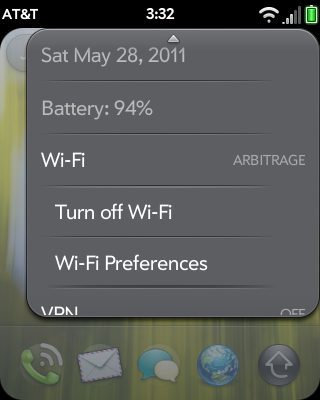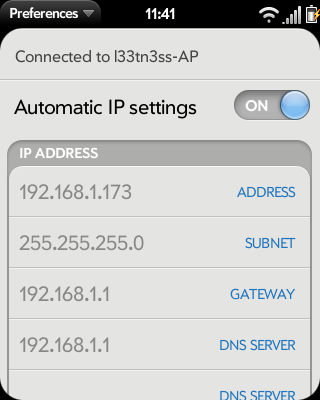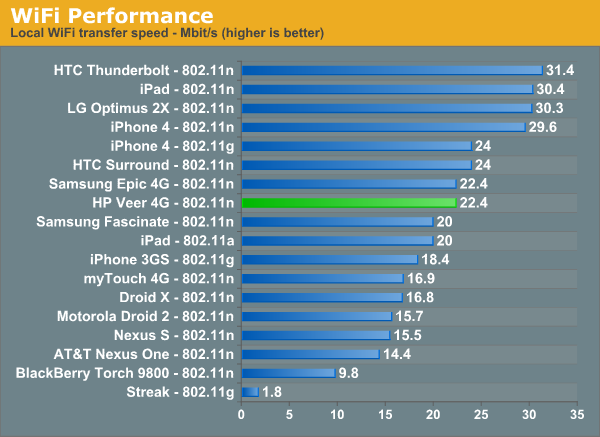HP Veer 4G Review - Getting Us Excited for Pre 3
by Brian Klug on June 7, 2011 5:01 PM EST- Posted in
- Smartphones
- HP
- AT&T
- Palm
- veer
- webOS
- HSPA+
- Mobile
- HP Veer 4G
Last week, Anand and I hopped on the phone with Qualcomm to talk about the finalization of its acquisition of Atheros. As it is right now, Qualcomm SoCs already come with both an application processor, GPS, camera ISP, encode and decode blocks, and the all important cellular baseband. There are one or two other chips that are part of the package as well for power management (in the case of the Veer’s MSM7230, the included PM8058 PMIC), and another for the RF front end and subsystem which can include Bluetooth and FM radio support (in this case possibly the QTR8600). All that’s missing from that list right now is WLAN, and Qualcomm’s long-term strategy is to eventually add it to the solution as well. I’m not sure whether the Veer uses it, but it’s possible that Qualcomm’s WCN1312 is its 802.11 b/g/n solution.


The fruits of having an SoC that includes connectivity are really evident in the Veer, which is both smaller and offers more connectivity than the Pixi it replaces. Recall for a moment that the Pixi included Bluetooth and GPS, but completely lacked any WLAN connectivity options. Space considerations are already a challenge in mobile devices, as having a smaller PCB means more volume that can potentially be allocated to a battery. It’s an even bigger constraint for the smallest of mobile devices. Not having additional die for the baseband, its accompanying NAND, and possibly another power management IC is an appealing space and power savings. Nvidia knows it just as well as Qualcomm, having recently acquired Icera for their cellular baseband IP. Having the same consolidation take place for WLAN would be yet another potential selling point for Qualcomm SoCs. Right now, the far and away most popular WLAN stack is Broadcom’s BCM4329 - it includes 802.11a/b/g/n (5 GHz support comes if you include the RF for it) alongside Bluetooth 3.0 and FM radio support. As an aside, many more mobile devices need to include 5 GHz WiFi support, the 2.4 GHz band is unusable at conferences and incredibly crowded in urban contexts.

The Veer supports single spatial stream 802.11n (2.4 GHz) with short guard intervals, and thus connects at 72 Mbps. In our throughput test, which consists of a PDF over 100 MB being loaded over WiFi using the Veer’s browser, we saw an average throughput of 22.4 Mbps over WiFi. I’m not entirely certain which WLAN stack is being used in the Veer, but it’s very likely either BCM4329 or Qualcomm’s own WCN1312. Given the size constraints and HPalm’s recent switch to everything Qualcomm, it seems possible that WCN1312 is the chipset of choice.
WiFi sensitivity on the Veer seems par, I can make it to the same point and drop off the network as most other devices.










25 Comments
View All Comments
ClockerXP - Saturday, June 11, 2011 - link
Dial ##3-836# to get to the menu where you can disable 3G. Works on my Pre+ on Verizon!ClockerXP - Saturday, June 11, 2011 - link
I mean ##3836# (no dash)dananski - Sunday, June 12, 2011 - link
I agree that the hardware is better than people say. I haven't had any problems with mine and it only has minor scratches from all the times I've dropped it. But the OS is good too. Cards and synergy are two things I couldn't go without, and I like the simple gestures.ioannis - Tuesday, June 7, 2011 - link
Brian, thanks for the comprehensive review, delivered in the usual Anandtech quality.The App Catalogue compatibility seems to be the only major complain I'd have over this phone. My question is, will WebOS 3.0 with the Enyo framework come to the Veer? And assuming that all the apps eventually get ported to it (or at least all apps released from the time 3.0 is out will be based on it), would that solve the 'pixel density'/resolution-dependent apps problem?
softdrinkviking - Tuesday, June 7, 2011 - link
Hi Brian. Great review. I especially liked your explanation of HSPA+, nice work there.I had one question. You again referred to Super LCD as (IPS) in this article, as you did in the article a few days ago (HTC evo 3D). In that article you crossed out the (IPS) and I assumed that meant you were reassessing that. Have you come to any conclusions about Super LCD and what process it is made with?
Brian Klug - Tuesday, June 7, 2011 - link
So I was mistaken earlier about Super LCD being IPS, I went over my notes and have written down that Super LCD is just PVA. I'm going to try and do some more digging to find out why I have that here and what the implications are. Honestly though the SLCD display on the Sensation looks quite good.-Brian
Solidstate89 - Tuesday, June 7, 2011 - link
I haven't owned a WebOS phone because of the flakiness of the hardware, but the OS has always appealed to me. Similarly although the Veer isn't for me, I do like just how much better WebOS 2.0 is looking.I sincerely wish them the best in the market as it is quite simply a brilliantly designed OS. However it's just taken too long to get to market. I wanted to get a Pre 3 on Verizon, but realized it would be too late with Verizon Wireless nixing its Unlimited Data plans before it could be released so I went to sprint and picked up a WP7 device.
Quite happy with it, and although it's a blatant rip-off, I can't wait for the card-style multitasking to arrive with the Mango Update :)
Best of luck to WebOS.
softdrinkviking - Tuesday, June 7, 2011 - link
cool, thanks for the reply & info. i have seen plenty of PVA screens in the store and they look pretty good to me, maybe not as good as the high-end NECs and other professional monitors, but i had a hard time telling the difference between the led backlit LG IPS and the similar sized BenQ with a PVA. (this is in Japan, so i can't say what models you have in the states).As long as they are good quality, and a decent resolution, I can't imagine that PVA would be unacceptable on a cel phone. they are undoubtedly better than TN.
jamawass - Wednesday, June 8, 2011 - link
I think the veer makes sense if you take into consideration hp's tablet strategy. A veer with mobile hotspot would be an excellent combo with a 7 in touchpad ( to be released after the 10 in later this yr). I have a 7 in sony reader which fits in all my jacket's pockets. That's my device of choice when I'm waiting at the auto shop, etc and I always receives glances when I whip it out of my jacket. It's light, and much more portable than an ipad.I suspect this is one of hp's strategies with the veer and I wouldn't be surprised if they market them as a combo deal in the future.
I've used webos for a year now and generally like it's efficiency, but Apple and other companies have been cannibalising their innovations. As stated above, hp needs to accelerate the upgrade cycle in both soft and hardware to survive.
marc1000 - Wednesday, June 8, 2011 - link
Brian and Anand, I could not find a way to contact you. So I will write this down on the comment section.Microsoft is killing the only thing cool on all older WindowsMobile phones (6.5 & below): the MyPhone service will die in a couple months.
please read this thread at XDA where some users reported receiving the same MS email with the news.
http://forum.xda-developers.com/showthread.php?t=1...